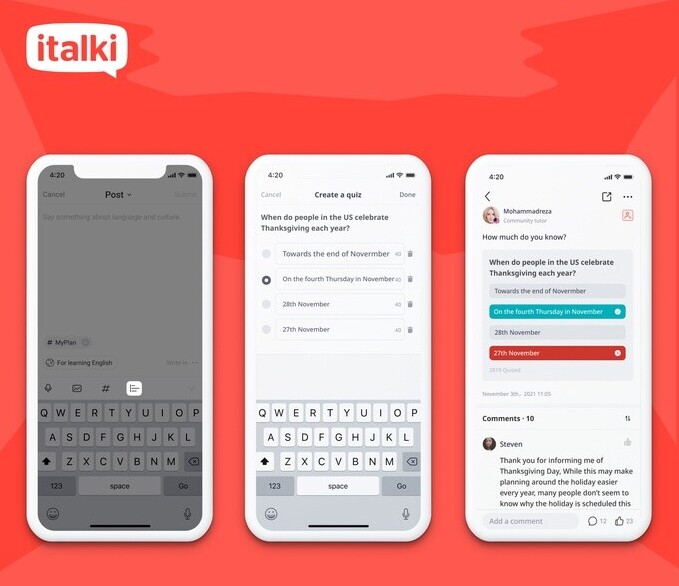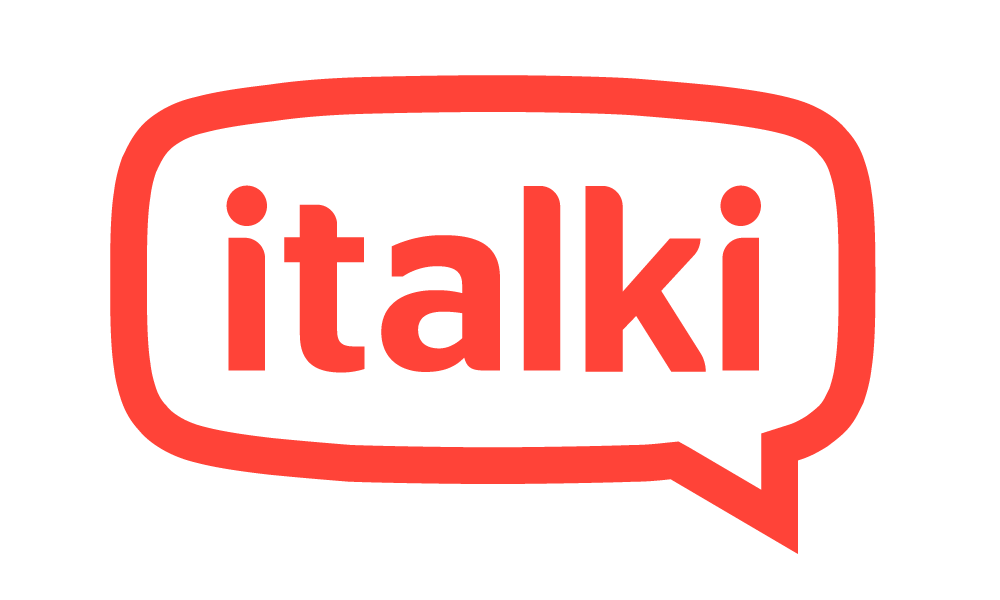If you’re looking for learning a language online, you’ve probably run across italki. As someone who’s tried a bunch of the popular platforms out there, I’ve got a pretty good handle on what italki offers, especially for students wanting real, measurable progress in their language skills.
I’ll walk you through my full review and break down everything you need to know, including what works, what doesn’t, and how italki compares to other tutoring sites like Preply. If you’re curious about supported languages, costs, class types, or even if italki can actually make you fluent, you’ll find it all covered here.

Platform Name: italki
Website URL: italki.com
Price Range: $5 – $60+ per lesson (varies by teacher and language)
Community Size: Over 5 million learners
Languages Supported: 150+ (see full list below)
Overall Rating: 4.6/5 (my personal score)
Trustpilot Consumer Rating: 4.6/5
Lesson Types: 1-on-1 video lessons, community practice
Free Trial: Varies by teacher; often first lesson at a discount
Mobile App: Yes, iOS/Android supported
italki has built its reputation as a super flexible way to learn languages directly from teachers around the world. With such a massive community and more than 150 languages to pick from, you get a ton of options. The main draw for students is usually the choice of teachers and the ability to customize your learning based on your own schedule, goals, and budget.
Here’s a quick sneak peek at the cool stuff students might appreciate, and some things you’ll want to watch out for.
Basic Info About italki
Launched back in 2007, yes, they have been around for a long time, italki started out with the simple idea that language learning gets way better when it’s personal and interactive. You connect directly with teachers, mostly through video chat. There’s no old school classroom setting, and you can jump into lessons from pretty much anywhere.
What’s cool is how you pick your own tutor based on price, reviews, teaching style, or even native accent. For students wanting to prep for exams, practice speaking in real conversations, or just brush up on grammar, there’s usually someone who can help. You can filter by teaching credentials, availability, and even the dialect or specialty you need (business, test prep, travel, basics, and so on).
Supported Languages on italki
One thing that really sets italki apart is the sheer number of languages you’ll stumble upon here. If you’ve had trouble finding a tutor in a less common language, like Icelandic or Swahili, italki is worth checking first. Here’s a sample of what you’ll find:
- Major world languages: English, Spanish, Mandarin, French, German, Japanese, Russian, Arabic
- Less common options: Icelandic, Albanian, Yoruba, Tagalog, Uzbek, Maori
- Regional varieties: US English, UK English, Cantonese vs. Mandarin, Latin American Spanish, Peninsular Spanish, Brazilian vs. European Portuguese
The current count is over 150 languages, and italki keeps adding more. So if you’re after something unusual or need a specific dialect for your job or travel plans, there’s a good chance you’ll find a teacher or conversation partner who fits.
How italki Lessons Work
On italki, you start by setting up a free account. Once you log in, you can browse hundreds (sometimes thousands) of tutors for your language. Everyone has a profile with a short intro video, a written bio, student reviews, and a calendar showing when they’re available. If you want to see what a teacher is really like, I recommend watching their intro video and reading a couple of their reviews; these give you a much better sense of their vibe than just the star rating does.
There are generally two types of teachers on italki:
- Professional teachers: These folks usually have language teaching credentials or professional backgrounds. They tend to offer structured lessons (great for test prep, grammar, or school support).
- Community tutors: These are native speakers who may not have formal teaching training but are solid for conversation, casual lessons, and real world speaking practice.
Most students mix and match, depending on their goals and how much they want to spend.
Booking Your First Lesson
After you’ve picked a tutor, you just select a time slot and pay for your lesson upfront. Some teachers offer a discounted “trial lesson” (usually 30 minutes) so you can see if your personalities and teaching or learning styles match up. You can check their recorded availability, so scheduling is simple.
All lessons are held online, mainly through italki’s own video system, but some tutors use Skype or Zoom if you both prefer. There’s also a chat function you can use after the session, which is handy for homework or follow up questions.
What to Expect During a Lesson
If you’ve never done language learning online, your first italki lesson might feel a little strange at first. But most tutors are super friendly and know how to make students feel at ease. You’ll usually start with a quick intro chat, talk about your goals, and then do some sample activities; anything from reviewing grammar to having a full conversation or learning travel phrases. Some tutors have their own PowerPoint slides, homework exercises, or digital textbooks, while others take a more relaxed, conversational route.
You can request homework or follow ups between lessons, which I find helpful for staying motivated and getting extra practice. If a tutor’s approach isn’t working for you, you’re free to try someone else without any extra hassle.
italki Credits and Payments
To pay for lessons, you use italki credits, which are basically just regular money in a digital wallet. You top up your account using a credit card, PayPal, or local payment options. Most lessons fall somewhere between $8 and $25 for 60 minutes, though it varies a lot. Trial lessons and community tutors are usually cheaper, sometimes under $10. Some rarer language pairs or highly qualified teachers run $40+ per session, but you’ll always see the price upfront before booking.
No subscription is needed; you pay as you go, which is handy if your schedule is crazy or if you just want to take lessons during school breaks. You can always top up your account as needed, which makes budgeting simple for students.
Key Features and Cool Tools for Students
italki isn’t only about video chats. There are a bunch of features built to make language learning more effective and interactive for students. Here’s what I think you’ll find most useful and a few extras that are easy to miss:
- Flexible teacher choice. You set your criteria—budget, lesson themes, dialects, age group, etc.—and filter teachers accordingly.
- Custom curricula. You’re not locked into any one program or textbook. Teachers adjust lessons based on your needs (school, test prep, travel, conversation, etc).
- Free community practice. Even if you’re tight on cash, italki’s “Community” section lets you ask and answer questions, exchange language tips, or get writing corrections from native speakers. It’s lively, and I’ve gotten useful study buddies and quick grammar feedback there.
- Official lesson reports and feedback. Teachers often leave feedback after sessions. Some even give you summaries, homework, or personalized practice assignments directly through italki.
- Language challenges and goal tracking. Some periods during the year, italki hosts challenges where you sign up to complete a certain number of lessons in a time frame. This is fun if you need extra motivation and like a mini competition.
- Integrated scheduling. The built in calendar auto converts time zones (a lifesaver if you’re away at school or traveling), so you won’t miss lessons because of a timezone mix up.
- Mobile app for learning on the go. You can chat, take lessons, and do all your scheduling through the app. I like using this during commutes or while waiting between classes.
- Group classes. These classes are designed for 2-6 students and focus on specific topics created by teachers. In these lessons you have an opportunity to interact with teachers and other students from around the world, practicing speaking, listening, and other language skills in a less stressed, more affordable, and multicultural environment.
- Community. It’s an space to connect, interact, and support each other in their language learning journeys. The platform emphasizes human interaction and cultural sharing as key to fluency. Key features of the iTalki Community include:
- Exercises: Users can practice and improve their skills through audio and written exercises.
- Questions: Learners can ask questions about grammar, translations, or any language-related queries and get help from native speakers or other learners.
- Posts: Users can share their learning milestones, stories, and general language learning experiences.
- Topics/Discussions: The community provides forums and sections for discussions on various language and culture-related topics, allowing users to meet, connect, and grow.
- Notebooks (Exercises): This feature allows users to write in their target language, and native speakers can then provide corrections, offering free language help.
- Language Partners: The community encourages users to interact with others learning the same language for language exchange.
- Italki plus with AI. It’is a paid subscription service that incorporates AI-powered features to enhance the language learning experience, primarily within the iTalki Classroom environment. Key AI-incorporated features in iTalki Plus include:
- AI-created Study Materials and Quizzes: The AI generates relevant study materials and quizzes based on your lessons.
- Progress and Goal Tracking: iTalki Plus helps organize language learning systems and tracks your progress towards your goals.
- Lesson Summaries: This is a prominent AI feature that automatically organizes key learning content from your lessons taken in the iTalki Classroom.

Why Students Use italki
I’ve met a ton of students using italki for pretty varied reasons. Some want to supplement their school classes, others need quick prep for language exams (DELE, HSK, JLPT, Goethe Institut, etc.), and quite a few just want to get confident in speaking before an exchange or travel program. Here are some situations where italki can really give a boost to students:
- Personalized support. One-on-one lessons mean you get 100% attention, which is super important if you tend to get lost in big school classes.
- Flexibility to suit your life. No need to lock yourself into a weekly class if your schedule changes often. You can change teachers, switch times, and target whatever areas you find tricky.
- Test prep help. Many teachers develop targeted sessions for exam preparation. If you need to improve a specific skill (speaking section, listening, writing), you can focus on that.
- Speaking confidence. Real conversation with a native is way different from textbook dialogues. Talking about your daily life, hobbies, or even your homework gets you thinking in the new language.
- Language maintenance. If you studied a language for exams but now want to keep it fresh, you can do occasional practice lessons.
- Variety of language options. Students in international schools or those planning gap years and study abroad can work on less common languages or particular dialects pre departure.
italki vs. Preply: Which One Is Better?
This question pops up a lot. Here’s my direct take as someone who’s used all three as a student.
italki vs. Preply
Both italki and Preply connect you with tutors for one on one online lessons. Here’s where they differ:
- Lesson Structure: Preply tends to focus more on long term, since they only work with subscriptions. italki is more casual about this; you can buy lessons one at a time, so it’s less pressure if you’re not sure how steady your schedule will be.
- Pricing: Both offer low prices for tutors. Preply, however, offers slightly cheaper prices, starting at $3, while in iTalki the minimum is $4.
- User Experience: iTalki is much more user friendly. The web gives you a feeling of being more robust and there are fewer errors in the classroom.
- Resources: Preply is ahead of the curve here, having developed courses available to teachers ranging from intermediate to advanced levels. With this, teachers, if they prefer, do not need to look for external materials.
- Community and Free Features: italki’s community section is a lot livelier, with free corrections, Q&A, and discussion posts. Preply doesn’t have as many free resources outside of paid lessons.
- Purchase of classes: A big difference between the two platforms is that on Preply you cannot purchase separate classes if you have not first purchased a subscription that will automatically renew each month. On iTalki, on the other hand, you can buy individual lessons and lesson packages. Personally, I prefer Preply’s model, as learning a language requires consistency and the subscription is a way to make things easier for you. However, if I am only interested in practicing for a short period of time or at a more leisurely pace, the iTalki model is better.
- Group classes: Italki have
- Community: Italki have
- Italki plus con IA incorporada
If you want flexible, one off lessons, I’d go for italki. If you want to commit to a fixed plan and work with the same tutor week after week, Preply is worth a look.
What Can Go Wrong: Disadvantages of italki
No review is ever truly finished unless you look at the downsides. Here’s what students sometimes struggle with on italki:
- No fixed curriculum. You’ve got to be proactive about your goals. Some teachers are super organized, but others let you drive the lesson structure. If you want a step by step program, you might need to ask for it or supplement with workbooks/scripts.
- Quality varies. There are thousands of teachers, so experiences can be hit or miss. Checking reviews and trial lessons helps, but occasionally you might not click with a tutor, or the lessons aren’t as detailed as you wish. Changing teachers is easy though.
- Connection/tech issues. Since lessons are run online, you might come across laggy video or bad audio here and there, depending on your or your teacher’s web connection.
- Time zone confusion. The platform’s calendar adjusts automatically, but sometimes teachers will cancel or switch lessons because of their own schedule, or because of daylight saving changes.
- One on one focus. If you like learning with friends, you might miss the group class energy. There aren’t group lessons or “classrooms” on italki.
- Pay per lesson can get pricey. While you’re not paying big tuition fees, regular sessions with top rated teachers do add up. You’ll want to budget or mix in free resources to balance it out.
Even with these cons, I think most are manageable if you approach the platform with clear goals. A bit of trial and error upfront (with trial lessons or switching tutors) usually fixes most fit issues.
Will italki Make You Fluent?
This is where I see the most confusion among students. italki gives you the tools, but you’ll need consistent practice and personal study in between lessons to actually become fluent. Here’s how italki fits into your overall learning:
- Spoken language boosts. Talking with a native, regularly, helps you build real world fluency and confidence much faster than passive apps or just reading a textbook.
- Direct feedback. In every lesson, your tutor can correct mistakes instantly, help with pronunciation, and give custom advice that you can’t really get from group classes, YouTube, or software apps alone.
- Practice, not magic. Even the best teachers can’t do the hard work for you. You’ll need to practice homework, review notes, and find ways to keep language in your daily life (movies, podcasts, reading, etc) to hit fluency.
Many students start speaking and understanding natural conversations much sooner with italki compared to traditional classes. But real fluency takes time, repetition, and a mix of activities beyond just 1 on 1 chats. I see italki as your accelerator, not a shortcut.
Learning Resources and Study Tools (Built In and Third Party)
One thing I really like about italki is the open approach to using extra materials; students and tutors can bring in anything that fits your style. Here’s how this works in practice and some favorites I’d recommend:
- italki Classroom Tools: Teachers often share their screens, use digital whiteboards, or link downloadable docs. There’s also a messaging system to keep track of resources and homework.
- Supplementing Practice: If you want to go deeper or want exercises between lessons, a lot of tutors will suggest (or bring their own) PDF workbooks, audio files, or links to online articles.
- Community Section: This part is free! You can post your writing or questions. Native speakers (sometimes even teachers) will leave corrections or comments. The language exchange here is super active, and corrections are usually quick.
- Third Party Pairing: Many students combine italki with Duolingo, Anki (for flashcards), Memrise, LingQ, or language textbooks. If you’re on a school curriculum, bring your own materials—most tutors are happy to use them.
Working like this bridges the gap between formal learning and real life use, so you’re not left in the “I can read but not speak” trap.

How to Pick a Good italki Tutor as a Student
Getting the right tutor makes or breaks your experience. Here’s what I recommend looking for as a student:
- Read recent reviews. Don’t just look at overall ratings. Read a handful of the most recent reviews to see what other students liked or struggled with.
- Watch teacher intro videos. This is the best way to get a sense of the teacher’s energy, clarity, and accent. You can usually spot if a tutor matches your vibe in under two minutes.
- Look for specialization. If you need school support (homework help, grammar), test prep (IELTS, TOEFL, DELE, etc.), or want a business focus, filter tutors by these shortcuts.
- Set up a trial lesson. Most teachers offer cheaper trial lessons, so you can test drive before committing. If you feel comfortable and like their structure after the trial, you’re on the right path.
- Message teachers first. You can reach out to ask if they have experience helping people at your level and goals. Some teachers respond with sample materials, so you see how they’d help before paying.
Don’t be afraid to switch tutors if something’s not clicking. The first lesson is for feeling that out, and it’s totally normal to change if you aren’t getting what you need.
How Does italki Compare to Other Tutoring Platforms?
If you’re shopping around, it’s smart to see how italki measures up to the competition. Here’s what I’ve noticed using a bunch of these services as a student:
- italki: Huge language variety, active free community, tons of teachers at every price point, and fully pay as you go. Best flexibility and range of lesson styles. You fully manage your lesson plan.
- Preply: Similar huge range and online video lessons, but more package based purchases.
- Verbling: Fancy site, great pro teachers, pricing is a bit higher. They focus only on professional teachers, not community tutors.
- Hellotalk: Peer to peer with no tutors, think WhatsApp for language exchange. Fun for daily practice, but no structure (and you’re learning from peers, not pros).
- Tandem: Like Hellotalk, it’s peer exchange focused, but they also have “Pro” tutors if you want to try paid lessons. The free features rely on chance matches rather than targeted teacher selection.
For most students, italki comes out on top for pure flexibility, truly global language support, and a supportive free community. If you want a more packaged curriculum or just want peer chats, other options might fit better, so it really comes down to what you want out of the experience.
add comparison table
Cost Breakdown: How Much Does italki Cost Students?
Because you pay per lesson and set your tutor’s price range, italki fits most budgets. Here’s a quick overview of pricing:
- Trial Lessons: $4-30 (usually 30 minutes, often with a discount for new students)
- Regular Lessons: $5–$60 per hour (most are $10–$25 for popular languages, $7–$15 for community tutors)
- Professional Teachers: Higher price, but many offer bundled discounts if you book 5, 10, or more lessons at once. You still aren’t locked in though.
You top up your italki credit (using bank card, PayPal, or local options) and buy lessons as you go. No monthly subscription required. Some tutors run promotions or offer loyalty deals if you’re a repeat student too.
If you want to keep learning on a super small budget, you can use the free community tools between lessons for writing, speaking corrections, and even occasional partner exchanges. This helps make your practice consistent without breaking the bank.
Tips for Making the Most of italki as a Student
After booking loads of lessons myself, I’ve picked up a few tips that really help students get the most value for their money and time:
- Set a clear goal with your tutor. Know what you want out of your lessons so your teacher can create structure and materials that actually work for your target (test, travel, improving grades, etc).
- Try a mix of tutor types. Combining a pro teacher for formal stuff with a casual community tutor for chit chat sessions is a strong combo.
- Schedule consistent reviews. Even if you’re crunched for time, try a 30 minute session weekly or biweekly to keep the ball rolling and brush up on problem areas.
- Supplement lessons with outside resources. Podcasts, YouTube, textbooks, and language apps turn what you learn in lessons into practical skills. Tell your tutor what you’re working on; they can craft lesson plans to reinforce it.
Student Ratings and Real User Reviews
Checking what other learners say helps you know what to expect. Here’s a sample of what students say about italki:
- Teacher quality: “Loved being able to pick tutors for different accents and lesson styles. Some teachers really went the extra mile to send practice homework.”
- Speaking practice: “I was finally able to practice real conversations for my school oral exam and got way less nervous speaking out loud.”
- Flexibility: “Flexible scheduling saved my butt during finals week when my study hours constantly changed. No pressure to buy packages was a bonus.”
- Community: “I made several international friends through the writing section and language exchange. Free corrections from native speakers are golden.”
- Cons: “Had a couple of teachers cancel or reschedule last minute, so always check timing and try trial lessons first.”

Frequently Asked Questions
What are the disadvantages of italki?
The biggest downsides are the lack of a set curriculum, some variation in teacher quality, occasional tech issues during lessons, and the fact that lesson costs can add up if you book a lot. Changing tutors until you find the right fit is common, and you’re in charge of driving your learning goals forward.
Will italki make you fluent?
italki helps you get much closer to fluency with regular speaking, listening, and feedback from native speakers. But you’ll need to back this up with personal study and real life language exposure. Consistency, plus mixing lessons with real world practice, is what makes fluency possible.
Which tutoring platform is best?
If you want options, flexibility, and community support, I personally think italki is tough to beat, especially for students who want to mix and match tutors and lesson types. Preply works well if you want a long term course with a single tutor.
Is italki better than Preply?
For flexibility, more teacher options, and a strong free community, I’d pick italki. Preply is more structured if you want to commit to lesson packages and stick with the same teacher over time.
Languages supported on italki?
Currently, you can learn over 150 languages on italki. Popular picks like Spanish, French, Mandarin, Japanese, Korean, Arabic, German, Italian, and Russian are all covered, alongside rare and regional languages. Pretty much, if you’re studying it for school or travel, italki probably has it.
Final Thoughts
For students serious about taking their language learning to the next level, italki is a handy platform that offers both structure and freedom. It’s not perfect; there’s a bit of trial and error in finding the right teacher, and progress depends on your effort between lessons, but the low barrier to entry, and the focus on personalized, practical learning make it worth a close look.
Want to try it for yourself? Signing up is free, and you can browse teacher profiles, try a discounted first session, or get involved in the community without dropping a cent. If you want to boost your grades, prep for exams, or just feel confident traveling abroad, italki’s flexibility and range of languages can give you the edge you’re after as a student.
If you’ve got questions about picking teachers, managing costs, or how to mix italki with your current studies, feel free to drop them in the comments—I’m happy to share my firsthand experience and help you make the most out of your language ride.

Guess what? When you click and buy through some of our links, you’re not just boosting your Spanish skills—you’re supporting us at no extra cost. It helps us keep delivering top-notch tips and resources to you. It’s a win-win for both of us!


